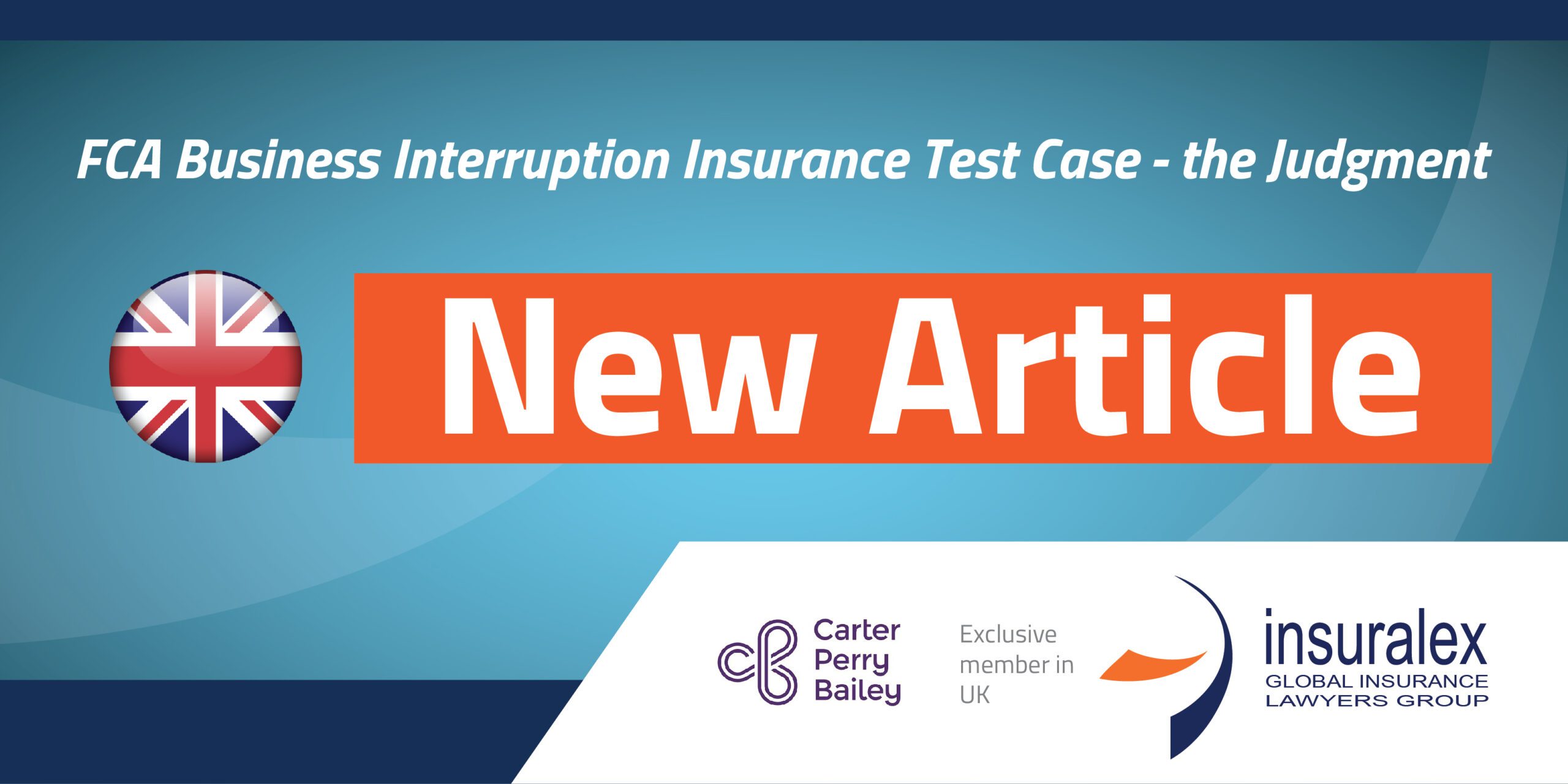
A summary of the judgment in the FCA business interruption insurance test case
Following the 8-day hearing of the FCA business interruption insurance test case, which commenced on 20 July 2020 (you can read our summary of the hearing and the background to the claim here), the High Court handed down its judgment on 15 September 2020. This judgment provides guidance on, amongst other things, the application of (i) prevention of access clauses; (ii) disease clauses; (iii) hybrids of the aforementioned clauses; and (iv) trends clauses. Lord Justice Flaux and Mr Justice Butcher found in favour of the FCA on a number of important points, including causation, many of the policy triggers and the application of the trends clauses. Most, but not all, of the sample disease and hybrid clauses considered by the Court were found to provide cover as were some of the prevention of access clauses. The full judgment can be found here. Below we summarise some of the key findings in relation to causation and the aforementioned clauses.
1. Causation
Insurers relied on the decision in Wayne Tank and Pump Co Ltd v Employers Liability Assurance Corp [1974] QB 57, which established that there will be no cover where the loss has been caused by interdependent concurrent causes, which include an uninsured peril (for example, the epidemic in this case) as it cannot therefore be proven that the loss was caused by an insured peril. However, the Court found that the application of this legal principle was not relevant in light of the Court’s finding that, however many proximate causes there are, they are all insured. The Court held that the proximate cause of the business interruption was the composite peril of the business interruption following the occurrence of the notifiable disease of which the individual outbreaks form indivisible parts or, alternatively, each of the individual occurrences was a separate but effective cause of the national actions.
2. Prevention of access clauses
Generally, there are four component parts required to trigger cover under this type of policy extension: (i) an incident which causes (ii) a competent authority to (iii) take action which (iv) prevents access to the insured’s business premises. Whether cover is triggered will depend on the precise policy wording. Below we address these component parts, in turn, by reference to the Court’s findings in relation to some of the specific terms in the sample policy wordings.
• The incident
Within the sample policy wording the causative incident is defined in a variety of ways, including “emergency in the vicinity“, “danger or disturbance in the vicinity“, “injury in the vicinity” and “incident Within 1 mile/the vicinity“. It was held that these were all requirements that aimed at specific incidences happening at a particular time, and in the local area. In contrast to the Court’s interpretation of the term “vicinity” in disease clauses (discussed further below), the Court found that these wordings were intended to provide narrow, localised cover. On this basis, it was concluded that for cover to apply under these policies, the restrictions imposed by the relevant authority would have to be in response to a local occurrence of the disease.
• The competent authority
Some of the sample wording required the prevention or hindrance of access to be the result of a “competent local authority“. Zurich had submitted in its skeleton argument that the Government did not amount to a public authority as contemplated by the relevant policy wordings. However, this point was abandoned by Counsel for Zurich in oral submissions. The Court found that “competent local authority” meant whichever authority was competent to impose the relevant restrictions in the locality on the use of the premises, including central government.
• The Action
A distinction was drawn by the Court between the requirements of the different sample policy wordings. Initial announcements by the Government were characterised as advice, rather than mandatory instructions, thus only potentially engaging clauses with “advice” wordings. On the other hand, it was held that “action” or an “order” which “prevents access” or restrictions which are “imposed‘ required the steps taken to have the force of law. The advice issued by the Government was considered to be insufficient to trigger cover under such policy wordings, whereas the later Health Protection (Coronavirus, Business Closure) (England) Regulations 2020 issued on 21 March 2020 and the Health Protection (Coronavirus, Restrictions) (England) Regulations 2020 issued on 26 March 2020 might be sufficient.
The restrictions imposed by these Regulations also differed depending upon the type of business. For example, under the 26 March Regulations, shops selling essential goods, such as food and medicines, were permitted to stay open, whereas shops that did not sell essential goods were forced to close. The parties to the test case categorised the policyholder businesses by reference to how they were impacted by the Regulations. There are 7 categories and these are set out at paragraph 53 of the judgment. To determine whether certain Government action may trigger cover, regard must be had to the precise terms of the policy wording and the actual effect of the Regulations on the specific insured business.
• Prevention of access
The precise terms of the prevention of access clauses differed across the sample wording analysed by the Court. The Court found that “inability to use” premises meant what it said and was not to be equated with “hindrance” or “disruption” to normal use. There would not necessarily be an inability to use premises simply because an insured could not use all of the premises, nor by reason of any and every departure from normal use. The Court decided that whether merely partial use would be sufficient to amount to an inability to use will depend on the facts of each case. However, the restrictions imposed did not have to be specifically directed at the insured or the insured’s use of the premises.
In relation to the term “prevention“, the Court found that this denotes impossibility. However, generally, actual physical prevention of access was not required; the insured had to demonstrate that there had been a closure of the premises for the purposes of carrying on the business or at least a fundamental change in the use of the premises. On the other hand, “hindrance” was found to denote a difficulty in the use/access of the insured premises but not impossibility. In this regard, the Court followed the distinction between prevention and hindrance as defined by Lord Atkinson in Tennants (Lancashire) Ltd v CS Wilson & Co Ltd [1917] AC 495.
The implication of this distinction was illustrated by the Court by reference to the effect of Regulation 4 of the 26 March Regulations on a restaurant with an existing take-away service. Whilst the Regulation required the restaurant to close so far as consumption of food and drink on the premises was concerned, it did not require the restaurant to close the premises to the extent it was used to provide the take-away service. In this scenario, cover requiring a “prevention of access” would not be triggered (save possibly where the take-away service was a de minimis part of the business). However, policy wording requiring a “hindrance” to access may be triggered on the same facts. Alternatively, if a restaurant set up a takeaway service which it had not carried on before, there may still be a qualifying “prevention of access“, since that takeaway business was fundamentally different from the business described in the policy schedule.
The Court also considered the interpretation of the term “interruption“. The Court found that this term generally extended beyond complete cessation of the business so as to include disruption and interferences with the business. Applying this to the aforementioned scenario in which a restaurant was required to close but could still provide an existing take-away service, the Court found that this would amount to an “interruption” of the business because, whilst there was not a complete cessation, there was a disruption to the business. An exception to this wide general interpretation of “interruption” (as incorporating disruption) was, however, identified by the Court in relation to the sample policy wording MS Amlin 2. Here, the policy wording referred to “interruption to your business caused by an incident”. Having regard to the remainder of the policy wording and in the absence of insuring clauses which point to “interruption” including “disruption”, the Court found that within MS Amlin 2, “interruption” must bear its strict meaning of cessation (and would therefore not extend to business disruption).
3. Disease clauses
Cover under this type of policy extension is generally triggered by the occurrence of a notifiable disease within a prescribed proximity to the insured business. Insurers submitted that the UK Government’s actions were not caused by a localised incident or occurrence, they were a result of the nationwide epidemic. Therefore, the relevant polices would not respond as actions outside the prescribed proximity that caused the closure of the insured business would not fall within the remit of an insured peril.
However, the Court disagreed. It found that cover was triggered by a national response to the widespread outbreak of a disease. Cover is not limited to outbreaks wholly within the defined area, because this had not been expressly stated in the policy and this interpretation would not be in keeping with the nature of the business interruption insurance product. Notifiable diseases include diseases which are capable of widespread circulation. By their nature, these diseases are likely to require a national response. Infectious diseases spread with no regard to policy areas. Thus, it is not meaningful to distinguish cases from inside a policy-area from those cases outside the same area. Generally, as long as the insured can demonstrate that the wider outbreak of the disease extended within any specified radius, cover will be triggered. Below we discuss the Court’s interpretation of some of the key policy terms found within the sample policy wording.
• Vicinity
In RSA’s Marsh/Jelf “Resilience” wording (described in the test case as RSA4), the covered area was described as the “vicinity“. This was defined as: “an area surrounding or adjacent to an Insured Location in which events that occur within such area would reasonably be expected to have an impact on an Insured or the Insured’s Business“.
It was held that when Covid-19 occurred, it was of such a nature that any occurrence in England and Wales would reasonably be expected to have an impact on insureds and their businesses. On this basis, all occurrences of COVID-19 in England and Wales were considered to be within the relevant “vicinity”. The Court pointed out that when a local outbreak is part of a wider outbreak, it would be difficult, if not impossible, to show that the local outbreak made a difference to the authorities’ response. The argument that causality could not be proven in these circumstances would lead to the result that there would effectively not be any cover; a result which the Court considered would be anomalous.
• Following
Certain sample policy wordings include a requirement that the business interruption or interference should “follow” the occurrence of disease. The Court found that the term “following” in this context suggested a looser causal connection than proximate causation. The requirement for proximate causation is between the loss claimed by the insured and the composite insured peril. Further, the Court found that, given the nature of the cover, proximate causation would be satisfied in a case in which there is a national response to the widespread outbreak of a disease.
• Incident or event
In two policy wording samples (referred to in the test case as QBE2 and QBE3), QBE provided cover for “loss resulting from interruption of or interference with the business… in consequence of” specific matters identified as “events”. It was held that, under these clauses, cover was limited to matters occurring at a particular time, in a particular place and in a particular way. The Court referred to the dictum of Lord Mustill in Axa Reinsurance v Field [1996] 1 WLR 1026 at 1035 as to the meaning of “event”. This intention was emphasised by the fact that the wording in QBE 3 covered a relatively small radius of only 1 mile, which the Court found to indicate that the parties had contemplated cover to be for specific, localised events. Further, in relation to the Court’s analysis of the sample policy wording referred to as the Hiscox NDDA clause, the Court found that the term “incident” should be given the same essential meaning as “event”.
Therefore, insureds with these policy wordings would be required to demonstrate a case of Covid-19 within the prescribed radius of the insured business which caused the business interruption. If there were occurrences of the disease at different times and/or different places then these would not constitute the same “event” or “incident”. This finding will also be of interest to reinsurers whose excess of loss contracts include “event” based aggregation clauses, in which the “event” from which a series of claims arose will determine whether cover is triggered and whether limits are reached. As ever, of course, the particular reinsurance wording will have to be applied to the particular claims concerned.
• Occurrence or manifestation
The Court found a distinction in whether the disease needed to be diagnosed depending on the precise policy wording. The Court held that the term “occurrence” required a person within the specified radius to have been suffering from the disease. However, they did not have to be diagnosed, whereas, the term “manifestation” required a diagnosed case of the disease.
4. Hybrid clauses
Certain policy wording used by Hiscox and RSA combined the requirements for an occurrence of a notifiable disease and the inability to use the insured businesses due to the resulting local authority restrictions. The Court’s approach to these terms was in line with the findings above in relation to the stand-alone prevention of access and disease clauses. Therefore, in relation to the wording relevant to the occurrence of the disease, the insurers’ argument that only local outbreaks were covered was rejected, whereas the prevention of access wordings were interpreted narrowly so as to require the imposition of a mandatory restriction (as opposed to guidance).
5. Trends clauses
Trends clauses are relevant to the calculation of the insured loss because they take account of the circumstances/trends of the insured business. Insurers relied on the decision in Orient Express Hotels v Assicurazioni Generali Spa (UK) (t/a Generali Global Risk) [2010] EWHC 1186 (Comm) to argue that the insured could not show that the business loss would not have been suffered ‘but for’ the insured peril because many businesses would have suffered loss in any event due to the Covid-19 epidemic.
However, the Court found that it was not bound to follow Orient Express in relation to the application of trends clauses and found, Obiter, that Orient Express had been incorrectly decided.
The Court held that, to consider the counterfactual scenario in a meaningful way, in relation to prevention of access clauses, the prevention/hindrance of access, any action of an authority and the causative emergency must all be stripped away. Similarly, in relation to disease clauses, the whole of the disease, both inside and outside the defined area, would have to be stripped out, not solely the cases within the defined area, as suggested by insurers. The Court did also find, contrary to the FCA’s submissions, that trends clauses do extend to non-damage policy extensions and that the effect of the pandemic on the insured business’ turnover before cover was triggered should not be extracted from the counterfactual analysis. To do so would allow the insured to recover loss which had not resulted from the insured peril.
CPB COMMENT
As a result of the judgment, the participating insurers that were found to have provided cover under the sample policy wordings, and many other insurers with similar policy wordings, are facing significant exposure in circumstances where they had not intended to provide cover for a national pandemic, as confirmed by QBE in oral submissions. This really emphasises the importance of clear and comprehensive policy wording.
The share prices of some of the participating insurers have spiked since the judgement in response to insurer statements confirming their respective revised exposures, which are comfortably within their worst-case forecasts. Many of the participating insurers will be considering an appeal. They will be weighing-up the potential adverse effects on their share prices and reputations. However, given the stakes, we continue to anticipate a leapfrog appeal to the Supreme Court. In the meantime, policyholders should carefully consider the terms of the high court judgment against their particular policy wording and, in the case of prevention of access policy extensions, the specific effect of the Government actions on their business, before making a claim.
Carter Perry Bailey has significant experience in reviewing business interruption insurance wordings. We are able to advise on whether COVID-19 losses are likely to be covered under the terms of a policy, as well as offer advice on policy wording for both insurance providers and policyholders that are considering changes to their standard cover.
 Bernadette Bailey
Bernadette Bailey
Partner
T: 0203 697 1903
M: 07887 645263
E: bernadette.bailey@cpblaw.com

Dean De Cesare
Associate
T: 0203 697 1912
M: 07425 355252
This information has been prepared by Carter Perry Bailey LLP as a general guide only and does not constitute advice on any s pecific matter. We recommend that you seek professional advice before taking action. No liability can be accepted by us for any action taken or not as a result of this information, Carter Perry Bailey LLP is a limited liability partnership registered in England and Wales, registered number OC344698 and is authorised and regulated by the Solicitors Regulation Authority. A list of members is available for inspection at the registered office 10 Lloyd’s Avenue, London, EC3N 3AJ.



 Bernadette Bailey
Bernadette Bailey
